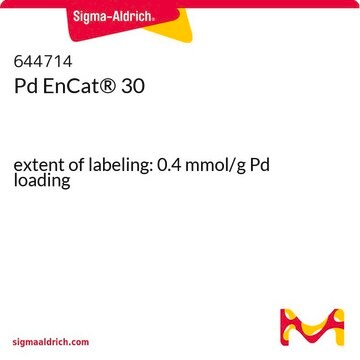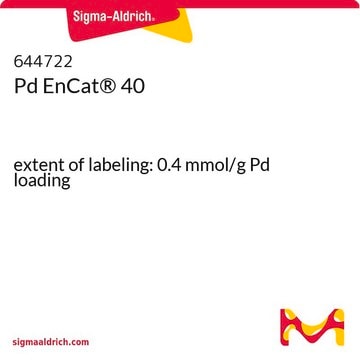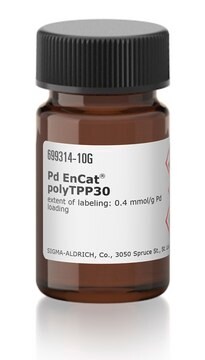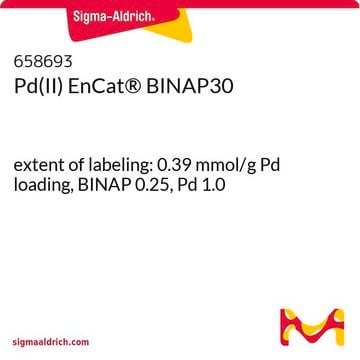644706
Pd EnCat® TPP30
extent of labeling: 0.4 mmol/g Pd loading, TPP 0.8, Pd 1.0
Synonyme(s) :
Palladium acetate and triphenylphosphine, microencapsulated in polyurea matrix
About This Item
Produits recommandés
Contient
0.26-0.35 mmol/g phosphorous
0.37-0.44 mmol/g palladium
Composition
Pd, 1.0
TPP, 0.8
Pertinence de la réaction
core: palladium
reagent type: catalyst
Capacité de réaction
reaction type: Buchwald-Hartwig Cross Coupling Reaction
reaction type: Heck Reaction
reaction type: Hiyama Coupling
reaction type: Negishi Coupling
reaction type: Sonogashira Coupling
reaction type: Stille Coupling
reaction type: Suzuki-Miyaura Coupling
Ampleur du marquage
0.4 mmol/g Pd loading
Description générale
Application
- Aryl iodides and bromides with terminal alkynes to form the corresponding coupling products under copper-free conditions.
- Bromobenzotriazoles and arylacetylenes in the presence of 1,5-diazabicyclo[5.4.0]undecene-5-ene (DBU) and copper iodide to form 2H-benzo[d][1,2,3]triazole derivatives.
Caractéristiques et avantages
- low residual metal levels in crude product
- easy recovery of catalyst
- compatibility of immobilized metal with various ligands to effect C-C bond forming reactions
- safer and easier to handle than Pd/C for hydrogenation
- efficiency and economy gains through recovery and recycling
Autres remarques
Informations légales
Mention d'avertissement
Warning
Mentions de danger
Conseils de prudence
Classification des risques
Aquatic Chronic 3 - Carc. 2 - Flam. Sol. 2 - Repr. 2 - STOT RE 2 Oral
Organes cibles
Liver,Kidney
Code de la classe de stockage
4.1B - Flammable solid hazardous materials
Classe de danger pour l'eau (WGK)
WGK 3
Point d'éclair (°F)
-9.4 - -7.6 °F
Point d'éclair (°C)
-23 - -22 °C
Équipement de protection individuelle
dust mask type N95 (US), Eyeshields, Gloves
Listes réglementaires
Les listes réglementaires sont principalement fournies pour les produits chimiques. Seules des informations limitées peuvent être fournies ici pour les produits non chimiques. L'absence d'indication signifie qu'aucun des composants n'est répertorié. Il incombe à l'utilisateur de s'assurer de l'utilisation sûre et légale du produit.
EU REACH Annex XVII (Restriction List)
Faites votre choix parmi les versions les plus récentes :
Déjà en possession de ce produit ?
Retrouvez la documentation relative aux produits que vous avez récemment achetés dans la Bibliothèque de documents.
Contenu apparenté
Homogeneous palladium catalysts are widely utilized due to their versatility, reactivity and functional group tolerance.
Notre équipe de scientifiques dispose d'une expérience dans tous les secteurs de la recherche, notamment en sciences de la vie, science des matériaux, synthèse chimique, chromatographie, analyse et dans de nombreux autres domaines..
Contacter notre Service technique





![[Pd(OAc)2]3 reagent grade, 98%](/deepweb/assets/sigmaaldrich/product/structures/508/249/99a0ef2c-b77c-4d73-8ed9-0cca05b6b41f/640/99a0ef2c-b77c-4d73-8ed9-0cca05b6b41f.png)


![RuCl(p-cymene)[(R,R)-Ts-DPEN]](/deepweb/assets/sigmaaldrich/product/structures/161/670/212e6eb8-dce1-4397-a5ef-3e2e3a296e8c/640/212e6eb8-dce1-4397-a5ef-3e2e3a296e8c.png)

